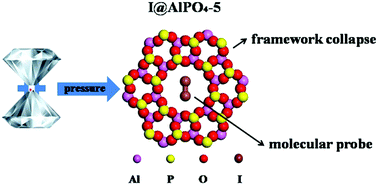A high pressure Raman study on confined individual iodine molecules as molecular probes of structural collapse in the AlPO4-5 framework†
Abstract
The mechanical stability of porous zeolitic materials has long been an important issue due to their advanced applications in many fields. Here, we choose to study the pressure induced structural modifications on the AlPO4-5 (AFI) framework. We find that the Raman characteristics of the confined iodine molecules in the AFI channels, with a low filling density, show discontinuities at around 3 and 10 GPa, which can be attributed to the implications of framework changes. Subsequent theoretical simulations on the AFI framework demonstrate that both a tilting mechanism along the c axis and a rotating mechanism in the ab plane of the tetrahedrons contribute to the structural deformation, and the AFI framework is collapsible at 4 and 10 GPa, which confirms those values found in the Raman studies. In this nanoconfinement system of I@AFI, the host and guest depend on and interact with each other mutually. No supporting effect on the AFI framework is found for the confined individual iodine molecules with such a low filling density, but they can be regarded as molecular probes to reflect the structural collapse of AFI. Thus, we provide a novel way to detect the structural deformation of porous materials under high pressure.

- This article is part of the themed collection: 2018 PCCP HOT Articles


 Please wait while we load your content...
Please wait while we load your content...